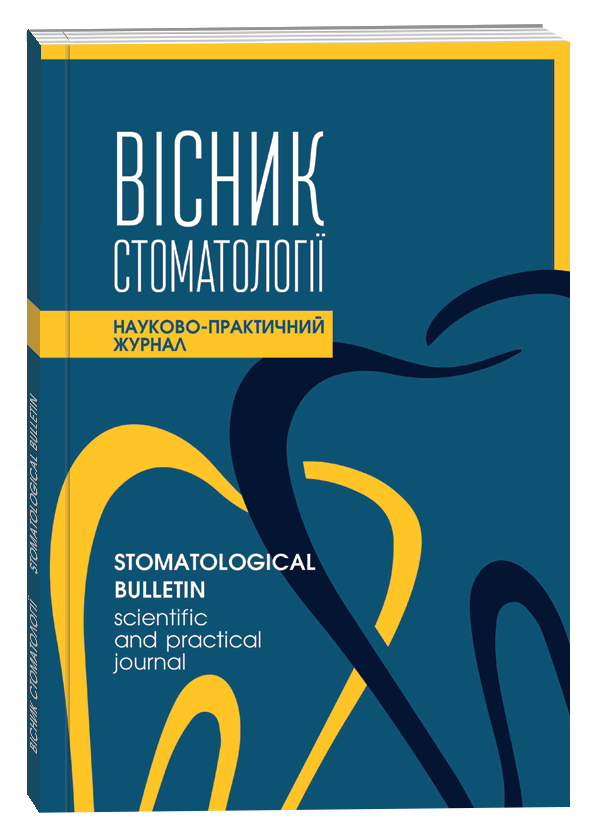CLINICAL RATING OF AESTHETIC ORTHOPEDIC TREATMENT METHODS OF PATIENTS WITH HARD DENTAL TISSUES DEFECTS
DOI:
https://doi.org/10.35220/2078-8916-2023-48-2.18Keywords:
tooth hard tissue defect, orthopedic treatment, fixed structures, metal-free prostheses, hygiene index, clinical ratingAbstract
Purpose of the study. Increasing the effectiveness of orthopedic treatment of patients with hard tissues defects through clinical substantiation and the use of improved methods of manufacturing metal-free fixed structures. Matherials and methods. According to clinical features and applied methods of orthopedic treatment patients are divided into the following groups. A general clinical examination 230 patients and study of the condition of the hard tissues of the teeth was done, analysis of the size and localization of defects in the dental rows, the analysis of diagnostic models were applied , condition of oral hygiene using the Silness- Low, gum bleeding PBI indices; X-ray examination methods were used. In order to evaluate the metal-free restorations, clinical evaluation methods according to the USPHS (Ryge) criteria will be applied. A 3D scanner is used to diagnose occlusal relationships and manufacture modern aesthetic metal-free denture structures. Scientific novelty. We have proposed a "Map of determining the level of aesthetics in patients", which takes into account: the color of the teeth, the shape of the teeth, the position of the front teeth, the level of attachment of the gums, the shape of the cutting edge, the type of incisal overlap, the presence of direct restorations, the presence of indirect restorations, the condition of the gums, bleeding gums, state of oral hygiene. An assessment has been made with use of proposed clinical methods of diagnosis and orthopedic treatment of patients with aesthetic defects using digital 3D technologies in the manufacture of metal-free aesthetic fixed structures of prostheses. The PBI index in patients of group 1 was 0.68±0.23 points before treatment and after 6 months – 0.38±0.05. The PBI index in patients of group 2 was 0.72±0.26 points before treatment, after treatment it significantly improved to 0.19±0.04 and after 6 months – 0.22±0.05. The Silness-Loe hygiene index in patients of group 1 was 0.54±0.3 points before treatment and after 6 months – 0.45±0.05. The PBI index in patients of group 2 significantly improved to 0.23±0.04 after treatment and after 6 months – 0.3±0.06. It should be noticed that this indicator 3 and 6 months after orthopedic treatment was significantly better in patients of group 2 who received the proposed treatment. When analyzing the criteria for restorations, we found that in patients who underwent restoration of hard tooth tissues according to the proposed method, the indicators are significantly higher than in patients who underwent restoration of hard tooth tissues using generally accepted methods. Conclusions. The clinical rating of indirect restorations indicates the advantages of using the proposed methods of orthopedic treatment of patients with defects of hard dental tissues with indirect restorations, in particular according to the characteristics of marginal adaptation between the tooth tissues and the restoration, color matching, restoration gloss, restored proximal contact and anatomical shape, according to which the Alpha criterion is established in 100% of patients. Also, according to the analysis of the PBI and Silness-Loe indices in patients, the indicators after 3 and 6 months after orthopedic treatment were significantly better in patients of 2 groups who received the proposed treatment.
References
Рожко М.М. Ортопедична стоматологія : підручник. Київ: Книга плюс, 2020. 752 с.
Galip Gurel. The Science and Art of Porcelain Laminate Veneers. Quintessence Publishing (IL), 2003. 525 p.
Massironi Domenico. Precision In Dental Esthetics: Clinical and Laboratory Procedures Hardcover. Quintessence Publishing Co, 1st edition, 2005. 400 p.
Stephen F. Rosenstiel, Martin F. Land, Junhei Fujimoto. Contemporary Fixed Prosthodontics. Elsevier Health Sciences, 2006.1130 p.
Herbert T. Shillingburg. Fundamentals of Fixed Prosthodontics : Quintessence Pub., 1997. 582 p.
Wong K. Y., Esguerra R. J., Chia V. Ai P., Tan Y. H., Tan K. BCh. Three-Dimensional Accuracy of Digital Static Interocclusal Registration by Three Intraoral Scanner Systems. Journal of Prosthodontics. 2018. 27. Р. 120–128 doi: 10.1111/jopr.12714
Mohammed Amr Labib, Amr Ragab El-Beialy, Khaled Hazem Attia. Evaluation of the Accuracy of Digital Models Obtained Using Intraoral and Extraoral. Scanners versus Gold Standard Plaster Model (Diagnostic Accuracy Study). Open Journal of Medical Imaging. 2020. №10. Р. 151-163 doi: 10.4236/ojmi.2020.103015.
Karasan D., Sailer I., Lee H., Demir F., Zarauz C., Akca K. Occlusal adjustment of 3-unit tooth-supported fixed dental prostheses fabricated with complete-digital and -analog workflows: A crossover clinical trial. Journal of Dentistry. 2023. №128. Р. 104365.
Fraile C., Ferreiroa A., Rubio M. R., Alonso1 R., Ramiro G. P.. Clinical study comparing the accuracy of interocclusal records, digitally obtained by three different devices. Clinical Oral Investigations. 2022. №26. Р. 4663–4668.
Краснокутський О.А. Клініко-експериментальне обґрунтування комплексного пацієнт узгодженого стоматологічного лікування хворих з дефіцитом м'яких тканин пародонта : дис.. … док. філософії : 221. Тернопіль, 2022. 284 с.
Kumhyr I., LevkoV., Ozhohan Z. Changes in immunological parametres in patients treated using direct and indirect restoration of the hard tissues of the anterior teeth in combination with an antioxidant. Journal of tissue engineering and regenerative medicine. doi: 10.1002/term.3054.









